That perfect lawn, the vibrant flower beds—they need a crisp, clean line to really shine. Without proper definition, your meticulously tended garden can bleed into the path, or your flower bed can start looking like an overgrown mound. It’s frustrating when all that effort seems to melt away because the boundaries are blurred.
Garden edging isn’t just about keeping the mulch in; it’s the defining feature that elevates your entire outdoor space from ‘nice’ to magazine-worthy. A well-chosen edge provides the necessary structure, acts as a subtle barrier to grass creep, and most importantly, frames your horticultural masterpieces.
If you’re tired of that fuzzy, unfinished look and are ready to create the kind of yard that makes your neighbors pause, you’re in the right place. We’ve compiled brilliant garden edging ideas, ranging from budget-friendly DIY fixes to sleek, modern installations, guaranteeing a solution that fits your style and budget. Get ready to give your garden the polished finish it deserves.
1. Brick Border Garden Edging
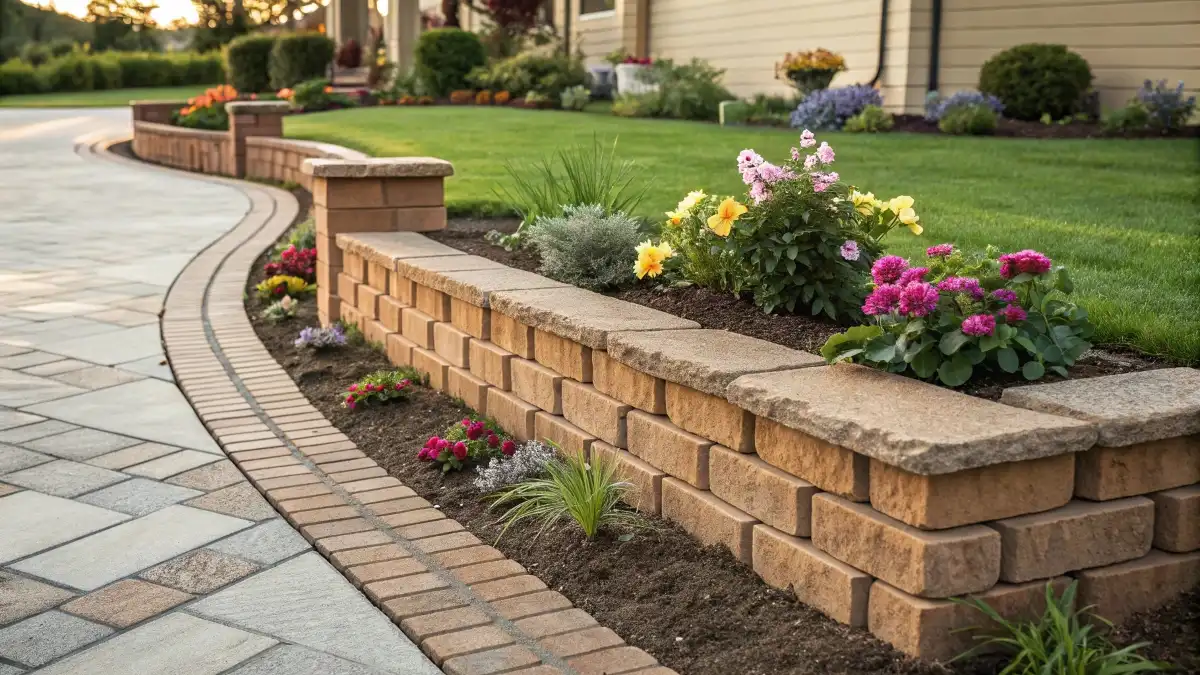
Brick border edging adds a refined touch to any front yard, blending structure with natural charm. Each brick interlocks seamlessly, creating a clean visual line that defines the garden bed while preventing soil from spilling onto the walkway.
Warm, earthy tone of the bricks harmonizes beautifully with the green lawn and colorful blooms, giving the space a balanced, welcoming feel. Low-maintenance and long-lasting, this design works as both a decorative accent and a functional barrier.
The curved pathway lined with bricks enhances movement and flow, guiding the eye through the landscape. It’s a classic choice that elevates curb appeal and brings order to a thriving garden without feeling too formal.
2. Sleek Stainless Steel Border
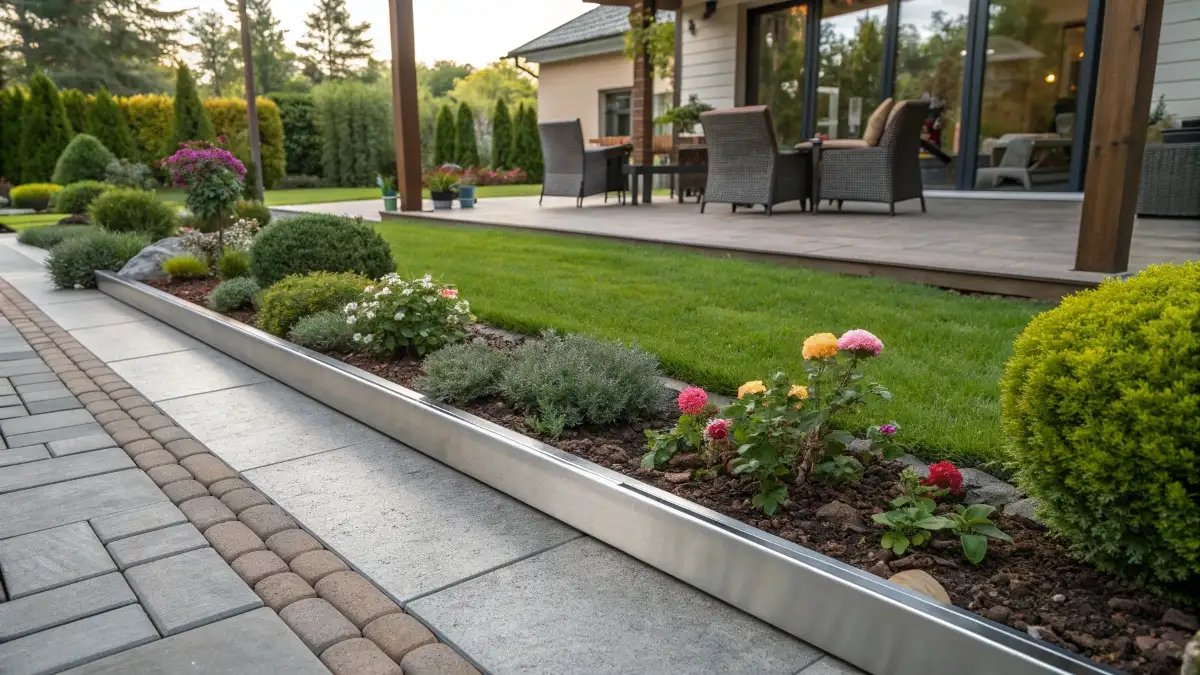
Stylish and durable solution for separating lawn and garden beds. The bright metal edging provides a crisp, clean line against the manicured lawn and the textured stone patio.
Moreover, this stainless steel border offers a modern aesthetic, enhancing the overall look of the outdoor space. You can see how effectively it contains the planting area, keeping mulch and soil neatly in place while preventing grass from creeping into the flowers.
Furthermore, the reflective surface adds a touch of sophistication that complements the contemporary home and patio furniture in the background. Choosing a sturdy material like this metal ensures longevity and minimal maintenance, making it a practical yet beautiful feature in any well-designed garden.
3. Flexible Recycled Plastic Border
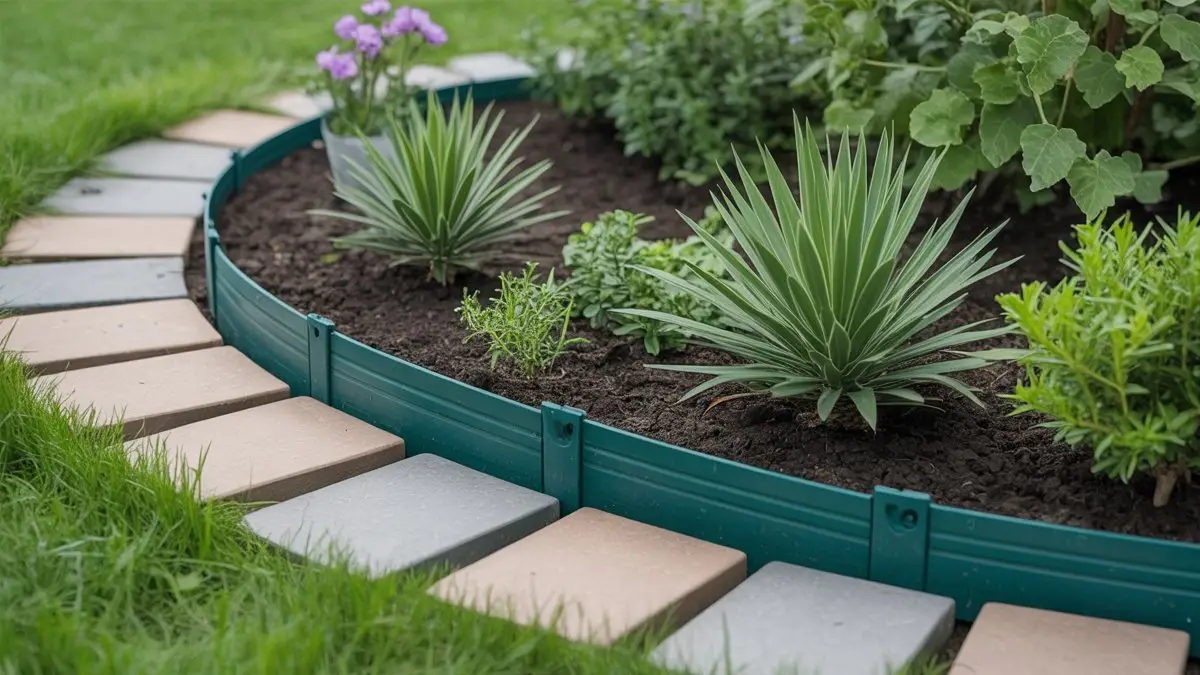
Practical and budget friendly method for defining a garden bed. The flexible plastic edging, colored a deep forest green, creates a neat, curved barrier around the planting area.
Notice how easily it forms a graceful arc, allowing for non straight edges that suit any garden shape. This border effectively holds the rich soil and mulch in place, protecting the vibrant green foliage within.
Moreover, the edging separates the garden from the adjacent stepping stone pathway, keeping the grass and stones distinct. Using this recycled material is a sustainable choice for your landscaping projects. The snap together or interlocking design makes installation simple for any homeowner.
4. Curved Concrete Paver Edge
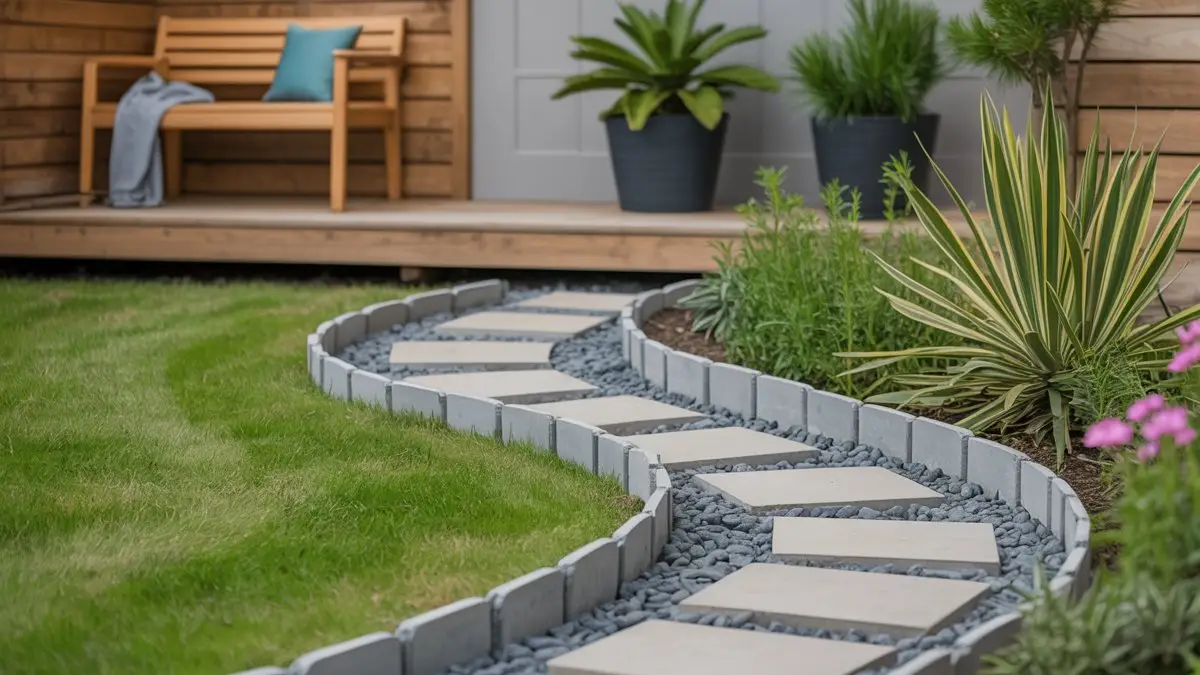
Lovely scene illustrates a sophisticated method for bordering a garden path. The precast concrete blocks create a textured, curving edge that beautifully frames the stepping stones and the lush garden bed.
Furthermore, dark decorative stones fill the spaces between the pavers, adding a contrasting element that enhances the visual appeal. This type of border provides a strong, durable separation between the vibrant green lawn and the cultivated planting area.
It also helps to keep the pathway materials contained and tidy. The subtle grey tones of the concrete blend harmoniously with the natural surroundings, contributing to a calm and inviting outdoor space. Choosing a robust material like concrete ensures a long lasting and attractive finish for your garden design.
5. Stacked Timber Retaining Wall
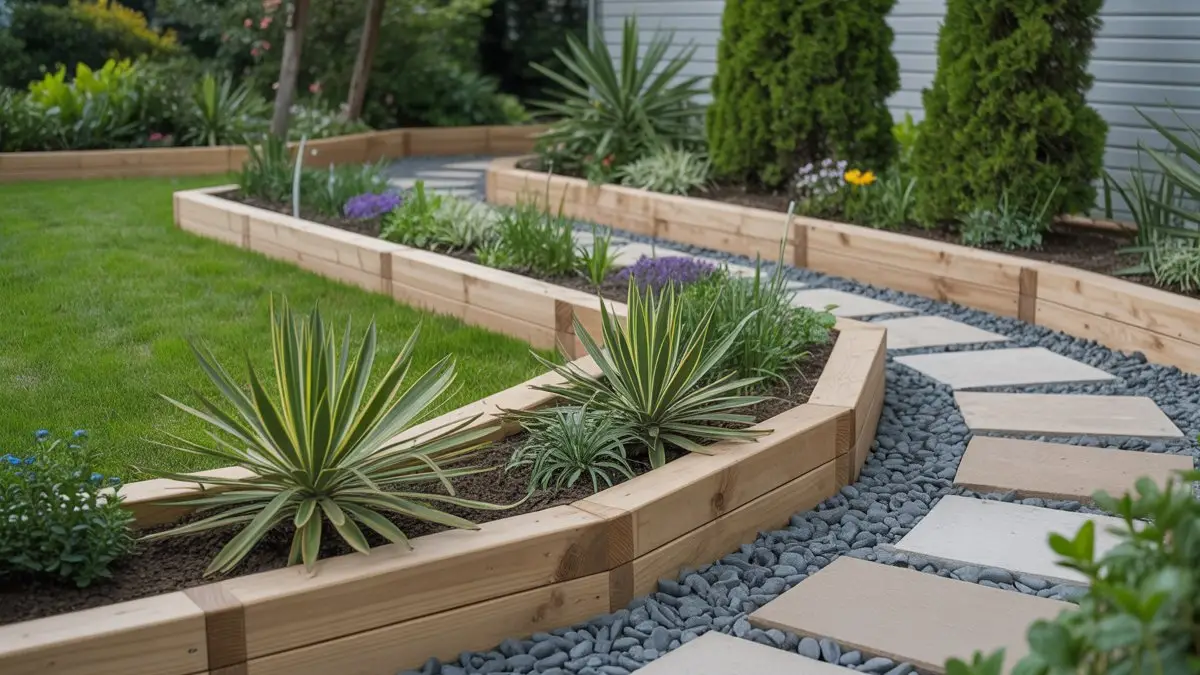
Multi level garden design using natural wood planks to create raised planting beds. The light colored timber offers a warm, rustic contrast to the dark soil, foliage, and grey stone path.
Stacked horizontally, the wood boards form sturdy barriers, effectively retaining the soil for the plantings. Notice how the curved design beautifully complements the winding pathway made of stepping stones set in river rocks.
This kind of robust timber edging works wonderfully for creating depth and structure in a landscape. The elevated beds help highlight the varied plant textures, from the spiky Yucca to the smaller, softer ground covers. Choosing this durable wood option adds a classic, appealing look that lasts for many seasons.
6. Natural Stone Wall and Flagstone Path
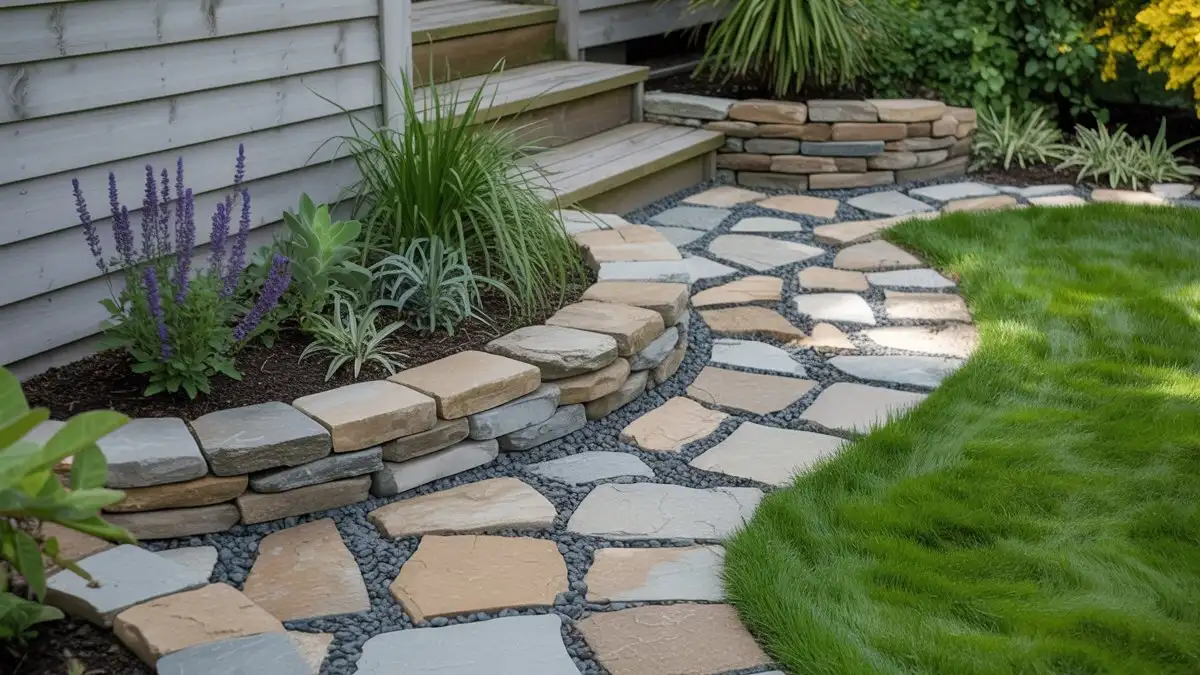
Stunning use of natural stone to create an engaging garden edge and pathway. A charming low wall, built from varying shades of grey and tan stones, elegantly borders the raised planting bed.
These stones provide a rugged, earthy texture that beautifully complements the surrounding greenery. Furthermore, a winding path of irregularly shaped flagstones, interspersed with dark river pebbles, guides the eye through the landscape.
This combination creates a striking visual contrast between the manicured lawn and the textured hardscaping. The natural materials blend harmoniously with the garden, offering a timeless and organic aesthetic.
This approach to garden edging is both decorative and functional, providing strong containment for the garden while also enhancing the overall charm of the outdoor space.
7. Rustic Timber Log Border
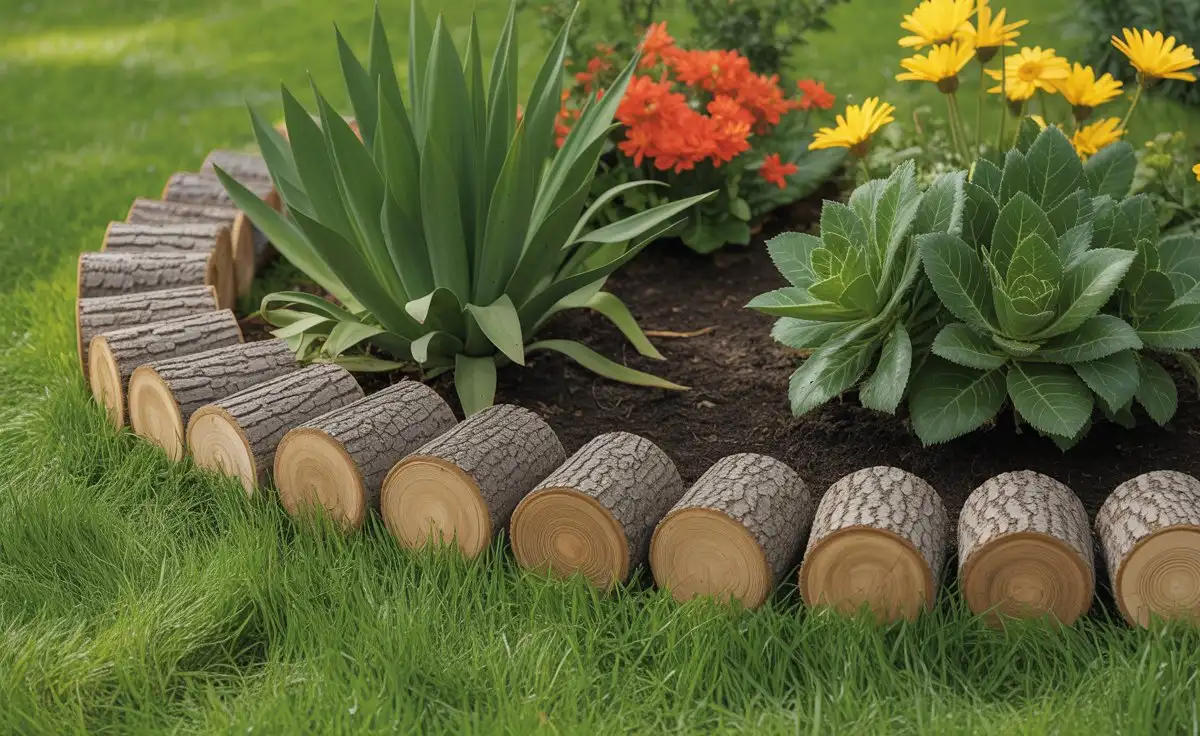
Charming, traditional approach to bordering a circular garden bed. The log roll edging, made from small, uniform pieces of wood, creates a rustic, natural boundary against the bright green lawn.
Each log features unique bark textures and visible end grain, contributing an earthy look to the landscape design. This simple barrier effectively separates the rich, dark soil from the grass, keeping the flower bed tidy and contained.
Notice the beautiful contrast between the sturdy, round logs and the sharp, pointed leaves of the central yucca plant. Additionally, the low profile of the timber edging lets the vibrant orange and yellow flowers take center stage. Choosing this type of edging is an easy, affordable way to introduce natural materials and a whimsical touch to any yard.
8. Textured Composite Plank Edge

Modern, low maintenance approach to defining a garden space. The composite plank edging, in a rich brown color, provides a clean, vertically structured border for the planting bed.
These uniform planks create a strong visual separation between the lush lawn and the winding path. The curved design of the edging guides visitors along the pathway, which features rectangular stepping stones set amidst smooth, dark grey river pebbles.
Composite material resists rot and fading, making it a very durable choice for busy gardeners. This type of manufactured edging offers the look of wood without the upkeep. It holds the soil firmly in place, keeping the tall grasses and other foliage neatly contained.
9. Scalloped Stone-Look Edging
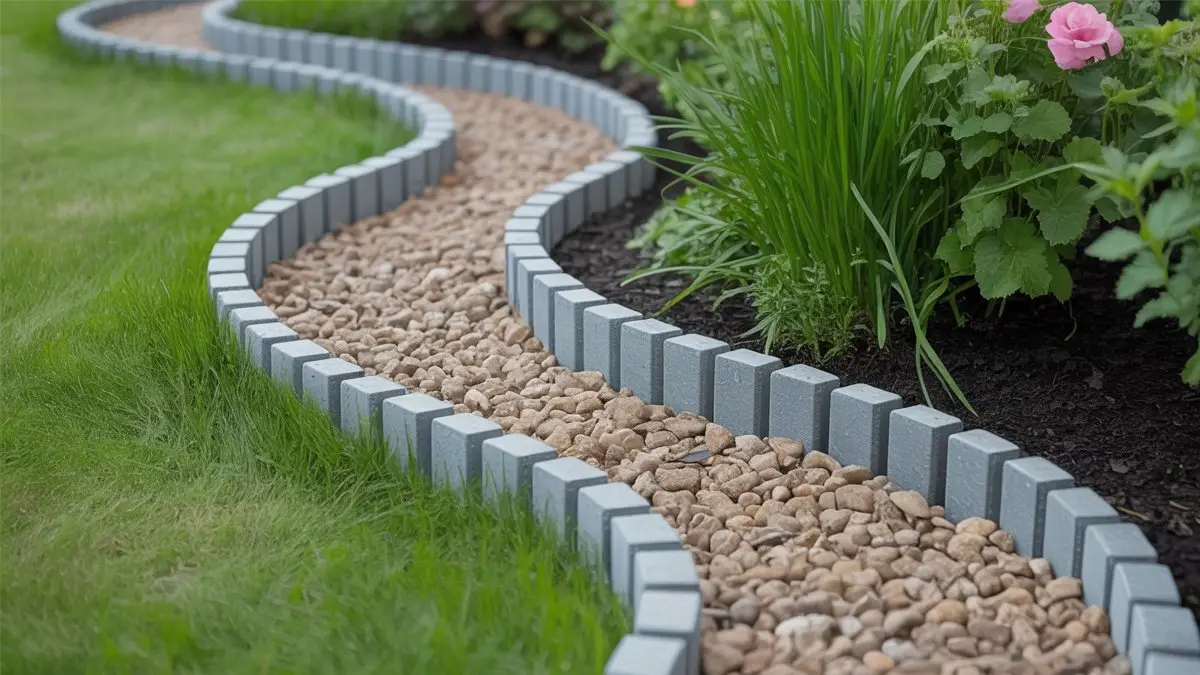
Scalloped edging, crafted to resemble small grey stones, forms a graceful, undulating line that separates the lush green lawn from a gravel pathway. This design not only looks attractive but also provides a sturdy barrier to keep materials where they belong.
The light brown gravel path, framed by the grey border, leads the eye toward a vibrant flower bed filled with dark soil and colorful blooms. This type of manufactured border offers the aesthetic appeal of natural stone with easier installation.
It effectively contains the garden elements, preventing soil erosion and grass encroachment. Furthermore, the repeating pattern adds visual interest and a neat finish to any garden design.
10. Natural River Rock Border
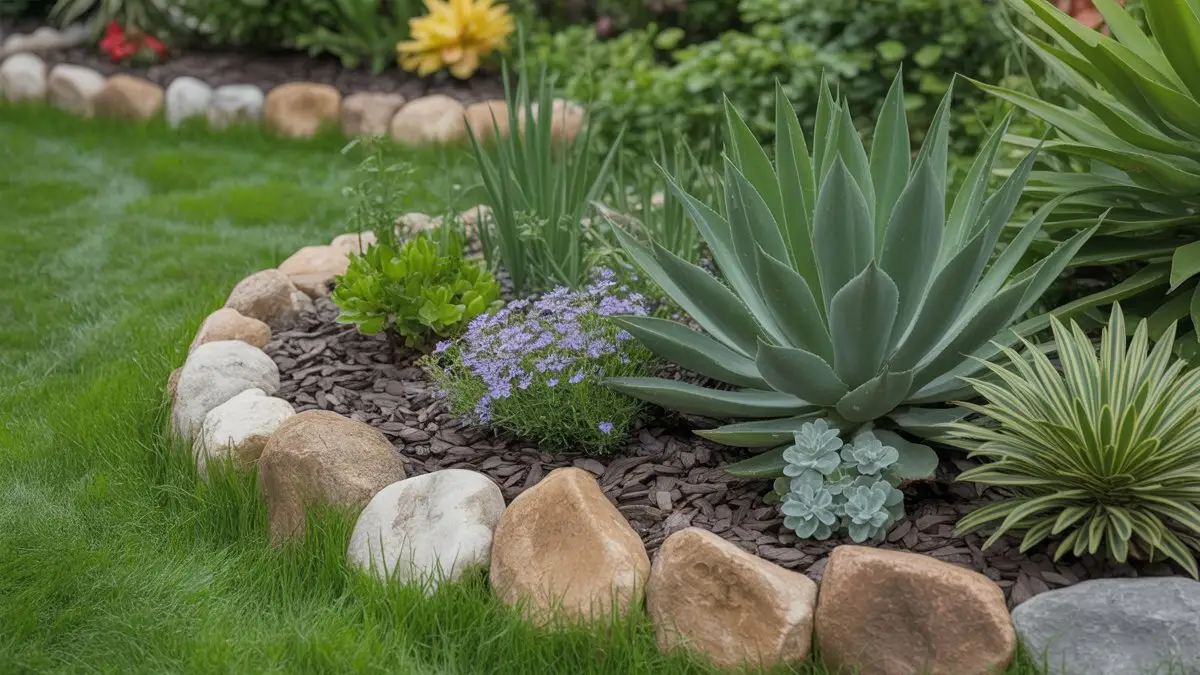
Classic and organic way to define a garden bed using natural river rocks. Large, smooth stones in various shades of brown, grey, and white are arranged to form a gentle curve that separates the vibrant green lawn from the richly planted garden.
This type of edging provides a soft, visually appealing transition while effectively containing the dark mulch and diverse plants. The rounded shapes of the rocks offer a calming, natural aesthetic that blends seamlessly with the outdoor environment.
It also creates a textural contrast with the spiky agave and other foliage in the bed. Choosing river rocks for your border is a durable and low maintenance option that adds rustic charm to any landscape.
11. Interlocking Brick Paver Path
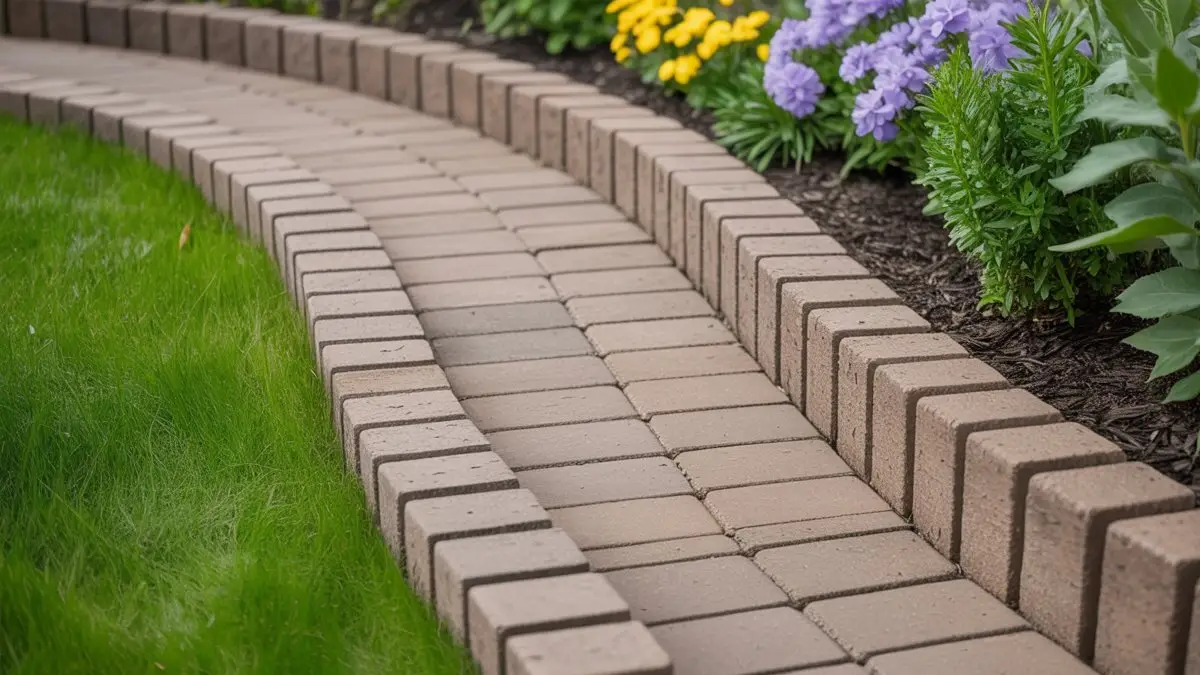
Structured path using rectangular brick pavers. The path itself is created from closely laid, flat pavers in an earthy tan color. Additionally, the path is framed by vertical brick-style units, forming a distinct and robust edge on both sides.
This technique not only defines the walkway but also elevates the area, offering a clear division between the bright green lawn and the dark mulched garden bed.
The continuous, repeating pattern creates a sense of order and flow through the landscape. Moreover, this type of paver edging provides excellent structural stability, preventing the lawn from spreading into the path or the garden. Choosing this durable, classic material gives a tidy, long lasting finish to any garden design.
12. Stacked Concrete Block and Paver Border
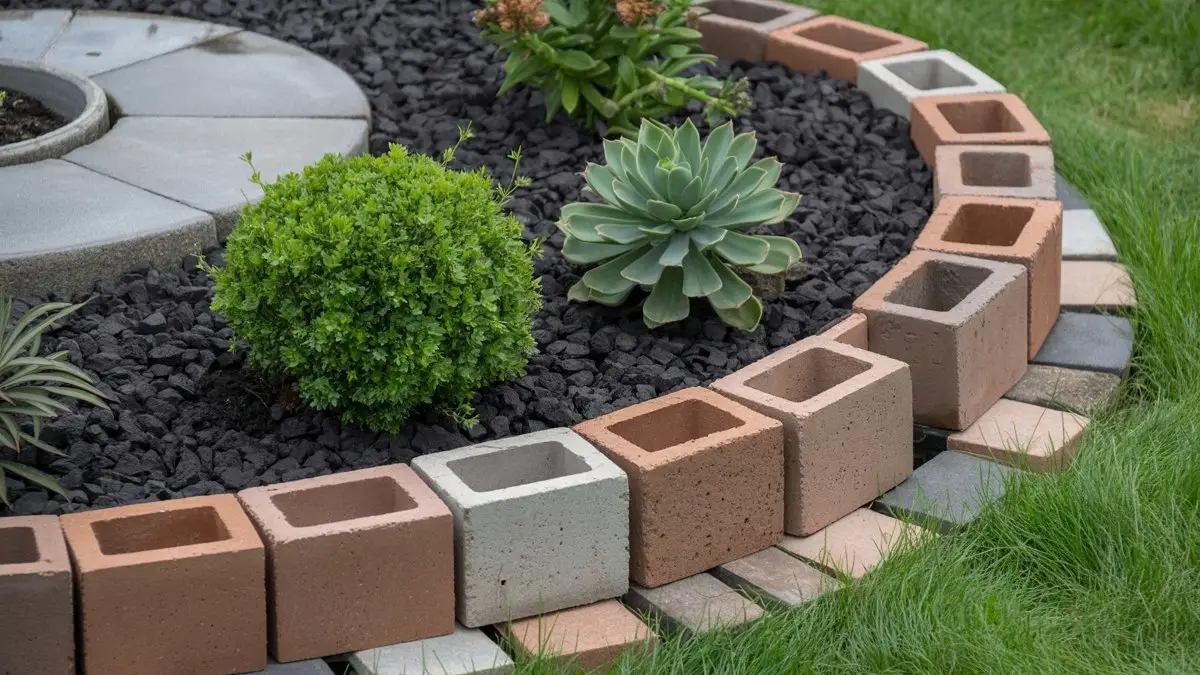
Layered approach to garden edging. A series of small, colorful concrete blocks rests vertically along the perimeter, forming a robust barrier. The blocks alternate between earthy terracotta tones and subtle grey shades, providing a pleasing mix of color and texture.
Notice how a row of flat paver stones lies directly beneath the blocks, creating a smooth transition to the bright green lawn. This tiered design offers both height and visual interest for the circular garden bed.
The open tops of the blocks add a unique structural element, beautifully contrasting with the dark decorative gravel used as mulch. Choosing this modular approach allows for easy construction of curved or straight edges while clearly highlighting the succulent plants within.
13. Modular Wooden Raised Beds
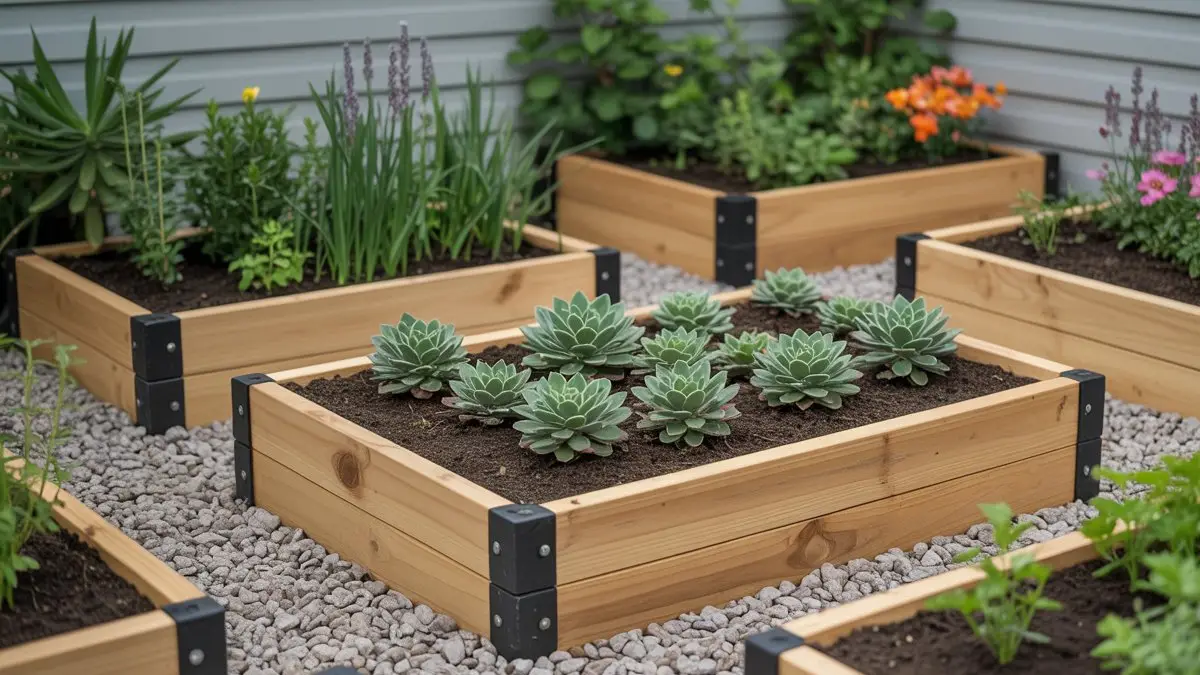
Attractive approach to gardening using wooden raised beds. The beds themselves are constructed from light colored wood planks held together by contrasting dark metal corner brackets, lending a modern, structured appearance.
These rectangular boxes neatly contain the soil and various plants, including succulents and herbs, allowing for specialized soil mixes in each area. Furthermore, the spaces between the beds are covered with light colored gravel, which acts as a clean, low maintenance pathway.
Building raised garden beds is an excellent way to improve drainage, reduce strain from bending, and create geometric interest in the landscape. This clean, modular design offers a functional and appealing solution for urban or small space gardening.
14. Durable Plastic Border for Stepping Stones
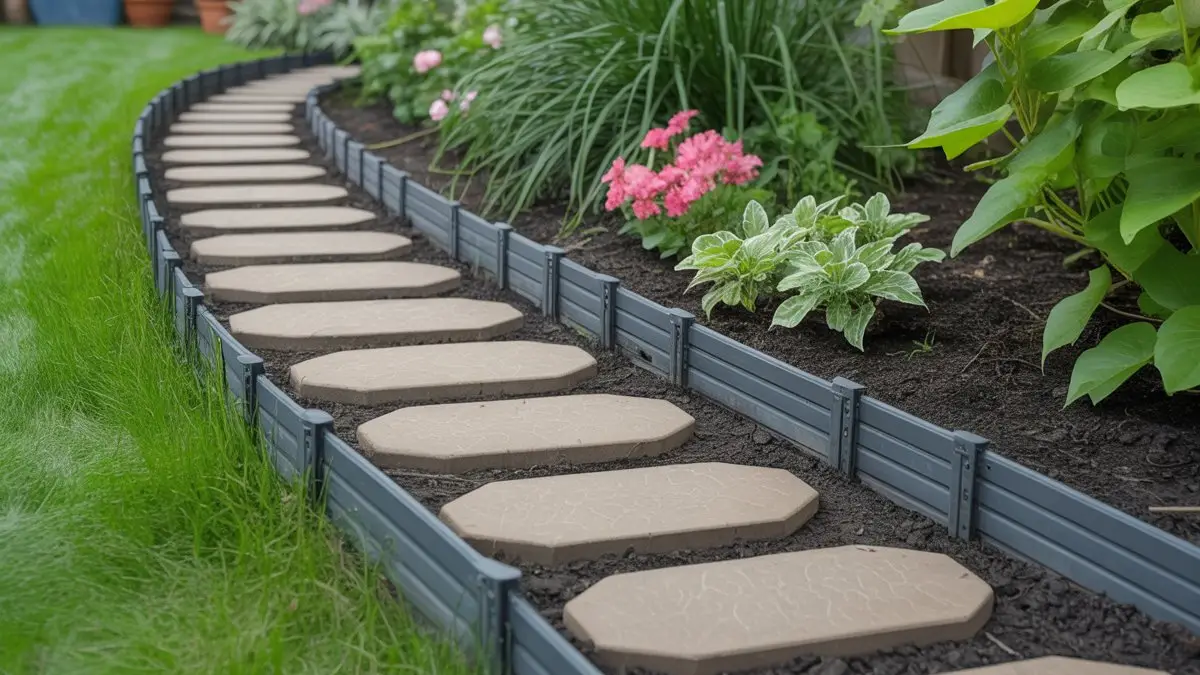
Dark grey, flexible plastic border creates a crisp line, separating the vibrant green lawn from a meandering path of stepping stones. These beige, oval shaped stones are neatly embedded in dark soil, leading the eye further into the garden.
The plastic edging effectively contains the path materials and prevents grass from encroaching into the cultivated areas. Furthermore, its ability to curve allows for natural, flowing designs that complement the organic shapes of a garden.
This type of durable plastic edging is a cost effective and long lasting choice for defining pathways and garden beds. It provides a clean, finished look while requiring minimal maintenance.
15. Layered Flat River Stone Border
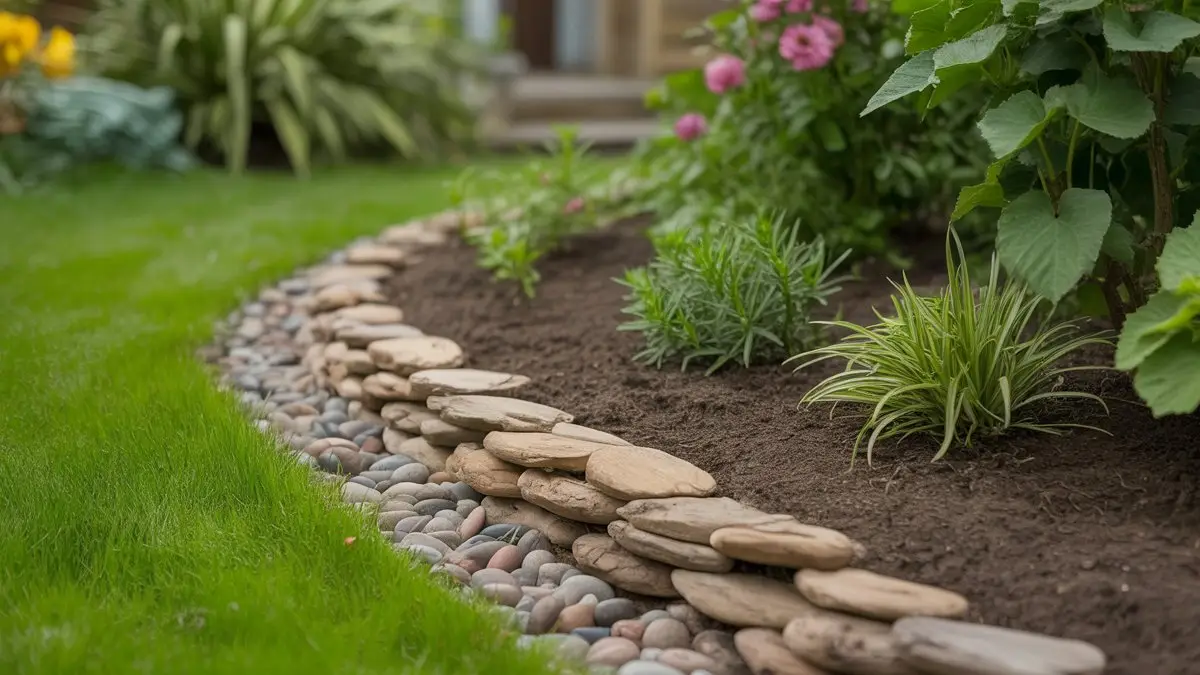
Elegant and natural approach to garden edging. A distinctive border is created using flat, oval shaped river stones, carefully stacked and arranged to form a low, curving wall.
These light brown stones offer a smooth, organic texture that contrasts beautifully with the rugged, multi colored pebbles laid on the lawn side of the border. This layered design effectively separates the vibrant green grass from the rich, dark soil of the planting bed.
Moreover, the varying sizes and shapes of the stones add depth and visual interest to the garden landscape. Choosing this type of natural stone edging provides excellent containment for mulch and plants while enhancing the overall aesthetic with an earthy, tranquil feel.
16. Rustic Flagstone Walkway Edging
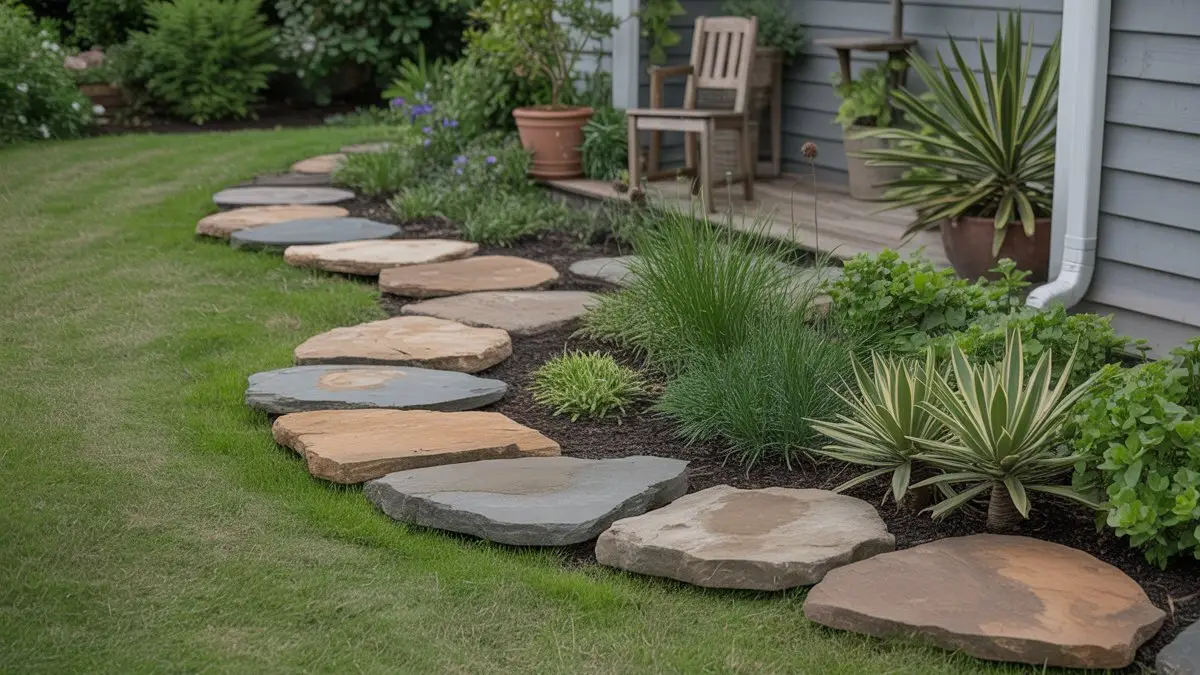
Simple yet elegant method for creating a garden path and border. Large, irregular natural flagstones, featuring varied shades of grey, tan, and rust, are laid directly onto the grass, forming a winding path.
The stones themselves act as the garden edging, offering a robust, natural separation between the bright green lawn and the mulched planting bed. This approach provides a soft, organic line that allows for easy mowing right up to the stone edge.
You can see how the different colors and textures of the stone complement the lush plants and the wooden deck in the background. Choosing large, flat stones like this creates a durable, non slip surface while adding undeniable rustic charm to the outdoor space.
17. Flexible Woven Bamboo Border
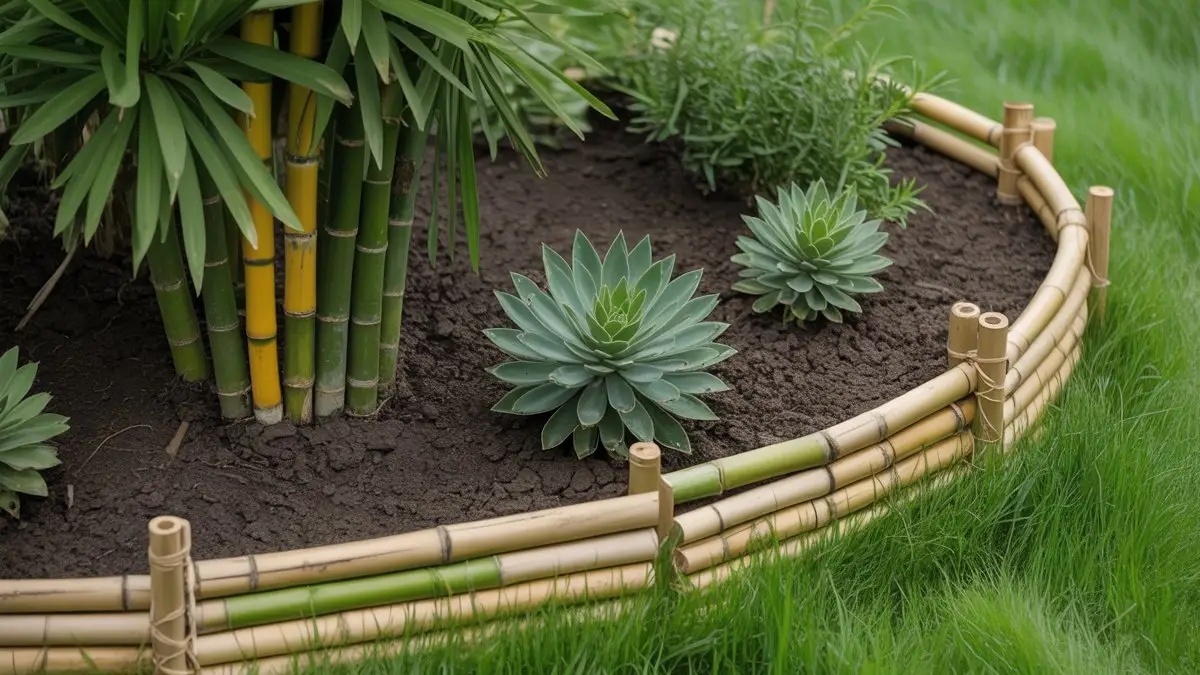
Exotic method for bordering a garden bed. Woven bamboo edging, secured with vertical stakes, creates a light colored, natural barrier against the dense green lawn. The golden and green tones of the bamboo offer a beautiful, tropical accent to the space.
This flexible material easily forms the smooth, circular shape needed to define the planting area. You can see how the edging effectively contains the rich soil, helping to showcase the striking succulents and the tall bamboo plant stalks within the bed.
Choosing a sustainable material like bamboo adds warmth and a distinctive texture to your landscape. This type of low profile border is simple to install and brings an immediate sense of tranquility to any corner of the yard.
18. Sculptural Pebble and Curb Edge
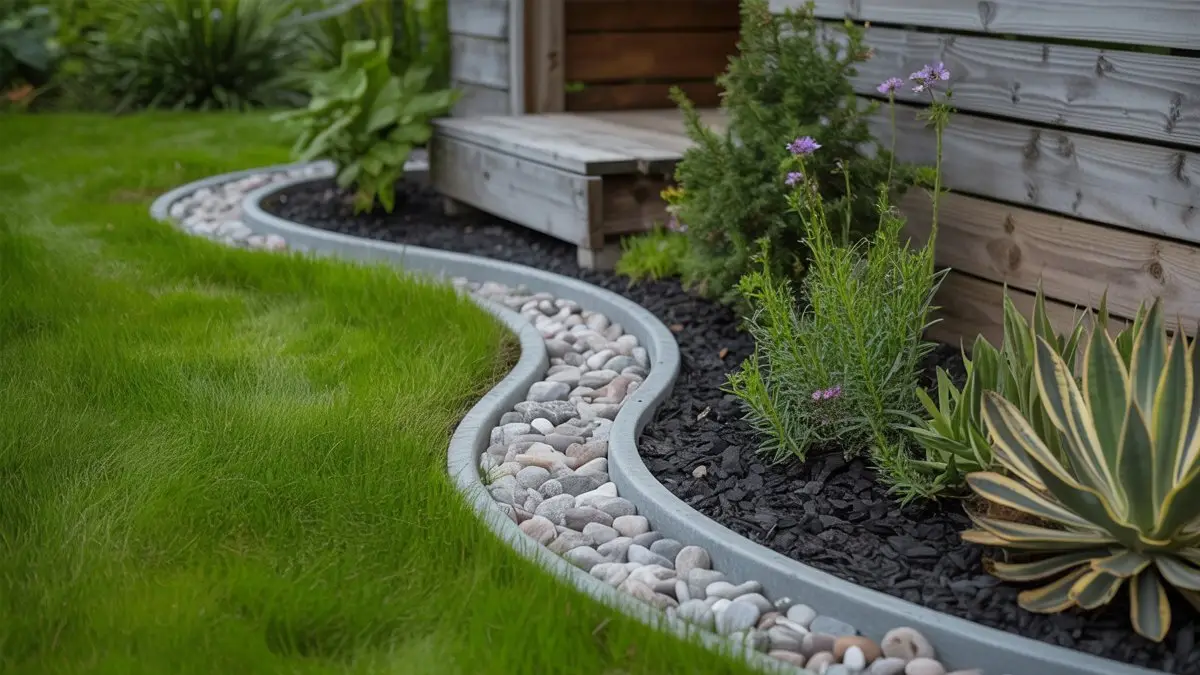
Contemporary approach to border design. A winding strip of flexible curb edging, in a smooth grey finish, separates the bright green lawn from the planting area.
Notice how this border creates a channel filled with light colored river pebbles, adding a beautiful textural element. This pebble-filled trench serves as a visually appealing and low maintenance buffer zone between the grass and the mulched garden bed.
The dark black mulch in the garden contrasts strikingly with the variegated agave and the wooden siding of the structure. Choosing this style of edging provides a clean, modern look while effectively preventing grass from creeping into your flower beds. This neat, organized system adds flow and structure to the overall landscape design.
19. Decorative Scalloped Wood Picket Edging
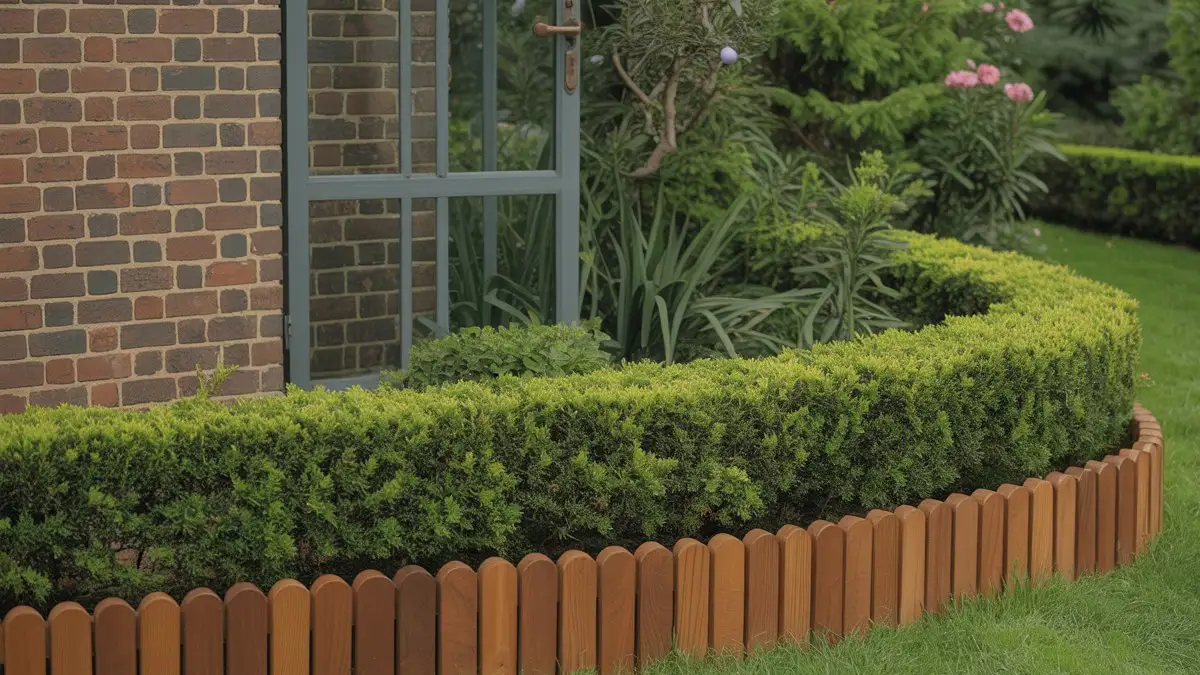
Reveals a classic and inviting method for defining a garden bed. A low, scalloped wood picket fence creates a rustic border between the lush green lawn and the dense, manicured hedge.
The individual wooden pickets, showcasing varying natural wood tones, are closely arranged to form a continuous, attractive edge. This type of edging provides a soft visual barrier that complements the vibrant green of the hedging plants.
It effectively keeps the lawn separate from the garden, maintaining a tidy appearance. Choosing this decorative wood border adds warmth and a traditional cottage garden feel to any landscape. The simple yet effective design is both functional and aesthetically pleasing, enhancing the overall charm of the outdoor space.
20. Classic Scalloped Border
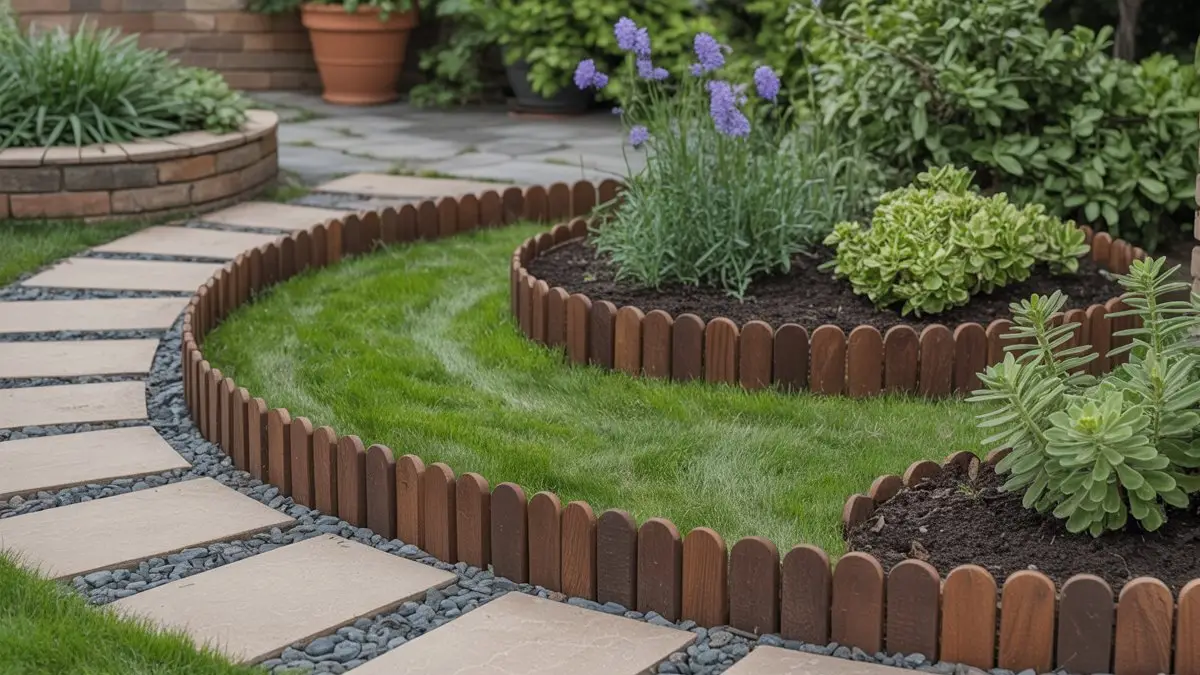
Traditional approach to garden separation. A border made of scalloped wood pickets, in a warm, dark brown finish, creates a soft, curving line that defines a small patch of lawn.
The individual pickets are uniformly sized, offering a neat yet rustic aesthetic that complements the surrounding hardscaping. This edging clearly separates the vibrant lawn from the stepped paver pathway and the raised planting beds.
Notice how the wood’s deep color contrasts beautifully with the light tan stepping stones and the dark grey pebbles beneath them. Furthermore, this flexible wooden border is easy to install and allows for effortless creation of curved shapes in the landscape. It provides a simple, welcoming barrier, keeping the soil contained and adding a quaint, cottage-style feel to the area.
21. Decorative Green Log-Look Edging
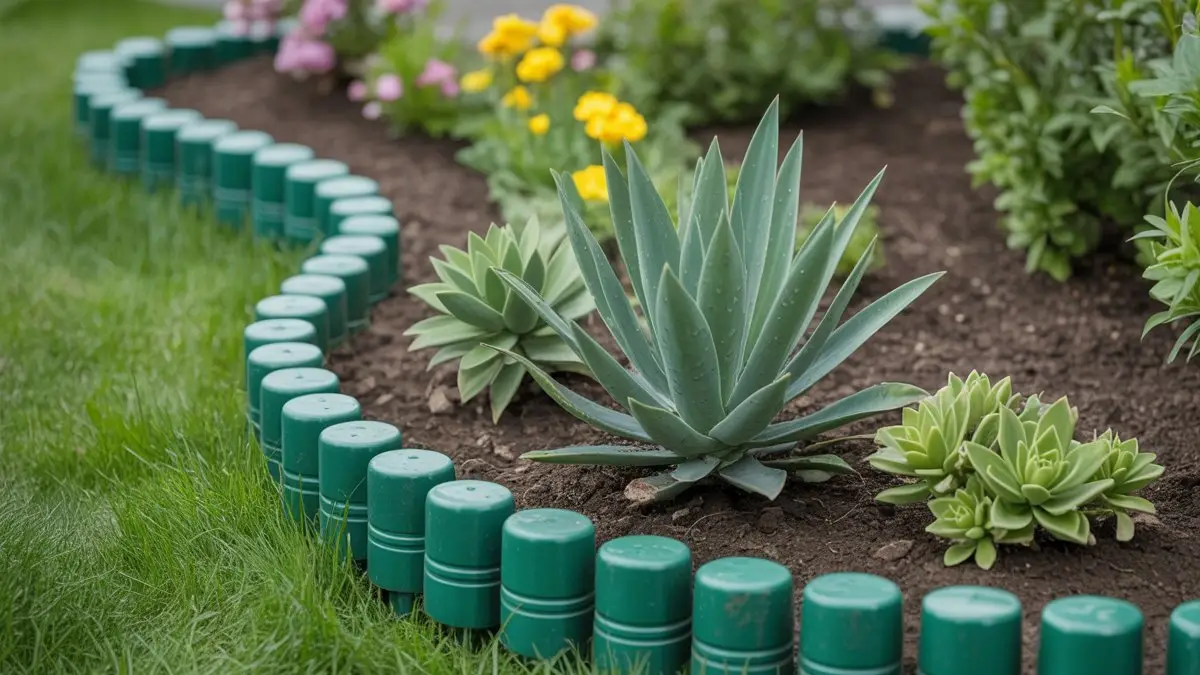
Tidy solution for outlining a garden bed. The border consists of round plastic edging in a vibrant green color, mimicking the look of small painted logs. Each uniform piece is closely set, creating a rhythmic, curving line that clearly separates the lush lawn from the planting area.
This type of edging provides a strong, low barrier that effectively keeps soil and mulch contained around the succulents and colorful flowering plants. Furthermore, the bright color of the border adds a cheerful, playful touch to the landscape design.
Choosing this durable log-look plastic is a simple, cost effective way to establish defined edges. It offers an easy to install, low maintenance option that gives a neat, organized finish to your yard.

